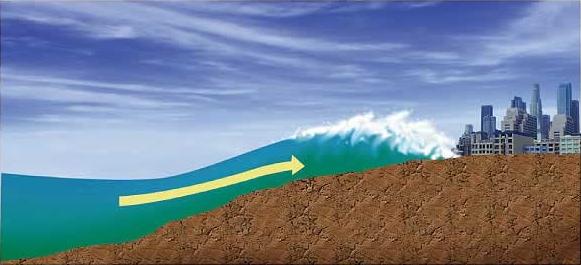The most destructive waves in the ocean are tsunamis, often wrongly called tidal waves. They are not caused by tides or even by the wind, but by underwater earthquakes, landslides or volcanic eruptions. These disturbances cause the sea bed to move very quickly, which shifts a large amount of water and disrupts the sea surface. A train of waves is set in motion which travel away from the source of disturbance.
Tsunamis travel extremely fast - up to 750km/h. They have a long wavelength, their crests often being 150km apart, so that a crest passes only every 15 minutes or so.
In the open ocean they are often less than a meter high and usually pass ships unnoticed. In shallow water, however, tsunamis change and as each wave reduces its velocity, the wave height builds up to tens of meters until it breaks.
In some places they do little damage, but where the shape of the sea floor concentrates the energy of the wave, tsunamis can cause devastation on the shore.
The eruption of a volcano in 1883 on the island of Krakatoa caused destructive tsunamis. Waves 30m high crashed into the nearby islands and even swept a boat about 3km inland.
The shores of the Pacific more than those of any other ocean have been damaged by tsunamis because volcanic eruptions and earthquakes occur frequently in that area.
The time tsunamis take to travel from a submarine disturbance to the nearer coasts and islands can be calculated from seismic readings, however, and adequate warning can usually be given.
